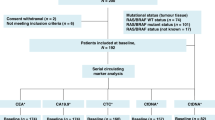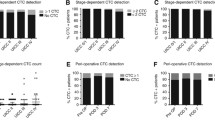Abstract
Purpose
Τo evaluate the clinical relevance of CEACAM5mRNA-positive circulating tumor cells (CTCs) in patients with metastatic colorectal cancer (mCRC).
Methods
Peripheral blood was obtained from 436 patients with mCRC before the initiation of systemic therapy. A second sample was obtained on treatment assessment from 296 (67.9%) patients. The detection of CEACAM5mRNA-positive CTCs was performed using a real-time PCR assay.
Results
The patients’ median age was 67 years and PS (EGOG 0–1) 92%; KRAS exon 2 and BRAFV600E mutated primary tumors were identified in 31.9% and 6.4% of the tested patients, respectively, whereas metastasectomy was performed in 17.7% of the patients. Circulating CEACAM5mRNA-positive CTCs were detected in 125 (28.7%) and 85 (28.7%) patients at baseline and on treatment assessment, respectively. The detection of CEACAM5mRNA-positive cells was revealed, in multivariate analysis, as an independent prognostic factor associated with decreased PFS (HR 1.6; 95% CI 1.1–2.5; p = 0.026) and OS (HR 2.2; 95% CI 1.3–3.2; p < 0.001). The detection of CEACAM5mRNA-positive CTCs in patients with KRAS and BRAFV600E mutations was correlated with shorter PFS (p = 0.041 and p = 0.022, respectively). Moreover, OS was significantly shorter in patients with CEACAM5+/KRAS mutations compared to those with CEACAM5+/KRAS wt tumors (p = 0.023).
Conclusions
Detection of peripheral blood CEACAM5mRNA-positive CTCs is an adverse prognostic factor correlated with poor clinical outcome in patients with mCRC, especially in patients with KRAS and BRAF mutated tumors.

Similar content being viewed by others
References
Ries LA et al (2000) The annual report to the nation on the status of cancer, 1973–1997, with a special section on colorectal cancer. Cancer 88(10):2398–2424
Jemal A et al (2010) Cancer statistics, 2010. CA Cancer J Clin 60(5):277–300
Jemal A et al (2009) Cancer statistics, 2009. CA Cancer J Clin 59(4):225–249
De Mattos-Arruda L, Dienstmann R, Tabernero J (2011) Development of molecular biomarkers in individualized treatment of colorectal cancer. Clin Colorectal Cancer 10(4):279–289
Sun YF et al (2011) Circulating tumor cells: advances in detection methods, biological issues, and clinical relevance. J Cancer Res Clin Oncol 137(8):1151–1173
Toss A et al (2014) CTC enumeration and characterization: moving toward personalized medicine. Ann Transl Med 2(11):108
Cabinakova M et al (2015) Predictive factors for the presence of tumor cells in bone marrow and peripheral blood in breast cancer patients. Neoplasma 62(2):259–268
Daskalaki A et al (2009) Detection of cytokeratin-19 mRNA-positive cells in the peripheral blood and bone marrow of patients with operable breast cancer. Br J Cancer 101(4):589–597
Grobe A et al (2014) Prognostic relevance of circulating tumor cells in blood and disseminated tumor cells in bone marrow of patients with squamous cell carcinoma of the oral cavity. Clin Cancer Res 20(2):425–433
Hartkopf AD et al (2014) Tumor cell dissemination to the bone marrow and blood is associated with poor outcome in patients with metastatic breast cancer. Breast Cancer Res Treat 147(2):345–351
Kruck S, Gakis G, Stenzl A (2012) Circulating and disseminated tumor cells in the management of advanced prostate cancer. Adv Urol 2012:135281
Lin H et al (2011) Disseminated and circulating tumor cells: role in effective cancer management. Crit Rev Oncol Hematol 77(1):1–11
Cohen SJ et al (2006) Isolation and characterization of circulating tumor cells in patients with metastatic colorectal cancer. Clin Colorectal Cancer 6(2):125–132
Cristofanilli M et al (2004) Circulating tumor cells, disease progression, and survival in metastatic breast cancer. N Engl J Med 351(8):781–791
Androulakis N et al (2012) Clinical relevance of circulating CK-19mRNA-positive tumour cells before front-line treatment in patients with metastatic breast cancer. Br J Cancer 106(12):1917–1925
Hou JM et al (2012) Clinical significance and molecular characteristics of circulating tumor cells and circulating tumor microemboli in patients with small-cell lung cancer. J Clin Oncol 30(5):525–532
Okegawa T, Nutahara K, Higashihara E (2009) Prognostic significance of circulating tumor cells in patients with hormone refractory prostate cancer. J Urol 181(3):1091–1097
Naito T et al (2012) Prognostic impact of circulating tumor cells in patients with small cell lung cancer. J Thorac Oncol 7(3):512–519
de Albuquerque A et al (2012) Prognostic and predictive value of circulating tumor cell analysis in colorectal cancer patients. J Transl Med 10:222
Matikas A et al (2017) Detection of KRAS exon 2 mutations in circulating tumor cells isolated by the ISET system from patients with RAS wild type metastatic colorectal cancer. Transl Oncol 10(4):693–698
Vardakis N et al (2011) Prognostic significance of the detection of peripheral blood CEACAM5mRNA-positive cells by real-time polymerase chain reaction in operable colorectal cancer. Clin Cancer Res 17(1):165–173
Liefers GJ et al (1998) Micrometastases and survival in stage II colorectal cancer. N Engl J Med 339(4):223–228
Schott A et al (1998) Isolated tumor cells are frequently detectable in the peritoneal cavity of gastric and colorectal cancer patients and serve as a new prognostic marker. Ann Surg 227(3):372–379
Stathopoulou A et al (2003) Real-time quantification of CK-19 mRNA-positive cells in peripheral blood of breast cancer patients using the lightcycler system. Clin Cancer Res 9(14):5145–5151
Gerhard M et al (1994) Specific detection of carcinoembryonic antigen-expressing tumor cells in bone marrow aspirates by polymerase chain reaction. J Clin Oncol 12(4):725–729
Goeminne JC, Guillaume T, Symann M (2000) Pitfalls in the detection of disseminated non-hematological tumor cells. Ann Oncol 11(7):785–792
Burchill SA et al (1995) Detection of epithelial cancer cells in peripheral blood by reverse transcriptase-polymerase chain reaction. Br J Cancer 71(2):278–281
Mori M et al (1996) Molecular detection of circulating solid carcinoma cells in the peripheral blood: the concept of early systemic disease. Int J Cancer 68(6):739–743
Hampton R et al (2002) Differential expression of carcinoembryonic antigen (CEA) splice variants in whole blood of colon cancer patients and healthy volunteers: implication for the detection of circulating colon cancer cells. Oncogene 21(51):7817–7823
Ko Y et al (1998) Limitations of the reverse transcription-polymerase chain reaction method for the detection of carcinoembryonic antigen-positive tumor cells in peripheral blood. Clin Cancer Res 4(9):2141–2146
Castells A et al (1998) Detection of colonic cells in peripheral blood of colorectal cancer patients by means of reverse transcriptase and polymerase chain reaction. Br J Cancer 78(10):1368–1372
Jung R et al (1998) Specificity of reverse transcriptase polymerase chain reaction assays designed for the detection of circulating cancer cells is influenced by cytokines in vivo and in vitro. Br J Cancer 78(9):1194–1198
Xenidis N et al (2009) Cytokeratin-19 mRNA-positive circulating tumor cells after adjuvant chemotherapy in patients with early breast cancer. J Clin Oncol 27(13):2177–2184
Saridaki Z et al (2011) Impact of KRAS, BRAF, PIK3CA mutations, PTEN, AREG, EREG expression and skin rash in ≥ 2 line cetuximab-based therapy of colorectal cancer patients. PLoS One 6(1):e15980
Douillard JY et al (2013) Panitumumab-FOLFOX4 treatment and RAS mutations in colorectal cancer. N Engl J Med 369(11):1023–1034
Park YJ et al (1999) Prognostic factors in 2230 Korean colorectal cancer patients: analysis of consecutively operated cases. World J Surg 23(7):721–726
Souglakos J et al (2009) Prognostic and predictive value of common mutations for treatment response and survival in patients with metastatic colorectal cancer. Br J Cancer 101(3):465–472
Saridaki Z, Papadatos-Pastos D, Tzardi M, Mavroudis D, Bairaktari E, Arvanity H, Stathopoulos E, Georgoulias V, Souglakos J (2010) BRAF mutations, microsatellite instability status and cyclin D1 expression predict metastatic colorectal patients’ outcome. Br J Cancer 102(12):1762–1768
Vlems FA et al (2003) Detection of disseminated tumour cells in blood and bone marrow samples of patients undergoing hepatic resection for metastasis of colorectal cancer. Br J Surg 90(8):989–995
Topal B et al (2005) Cancer cell dissemination during curative surgery for colorectal liver metastases. Eur J Surg Oncol 31(5):506–511
Seeberg LT et al (2015) Circulating tumor cells in patients with colorectal liver metastasis predict impaired survival. Ann Surg 261(1):164–171
Dienstmann R et al (2017) Prediction of overall survival in stage II and III colon cancer beyond TNM system: a retrospective, pooled biomarker study. Ann Oncol 28(5):1023–1031
Cao DD et al (2017) The impact of primary tumor location on efficacy of cetuximab in metastatic colorectal cancer patients with different Kras status: a systematic review and meta-analysis. Oncotarget 8:53631
Thomsen CEB et al (2017) The prognostic value of simultaneous tumor and serum RAS/RAF mutations in localized colon cancer. Cancer Med 6(5):928–936
Sastre J et al (2008) Circulating tumor cells in colorectal cancer: correlation with clinical and pathological variables. Ann Oncol 19(5):935–938
Cohen SJ et al (2008) Relationship of circulating tumor cells to tumor response, progression-free survival, and overall survival in patients with metastatic colorectal cancer. J Clin Oncol 26(19):3213–3221
Mani SA et al (2008) The epithelial-mesenchymal transition generates cells with properties of stem cells. Cell 133(4):704–715
Yu M et al (2013) Circulating breast tumor cells exhibit dynamic changes in epithelial and mesenchymal composition. Science 339(6119):580–584
El-Heliebi A et al (2018) In situ detection and quantification of AR-V7, AR-FL, PSA, and KRAS point mutations in circulating tumor cells. Clin Chem 64(3):536–546
Papadaki MA et al (2012) Analysis of the expression of stemness and epithelial-to-mesenchymal transition markers in circulating tumor cells of patients with breast cancer. Cancer Res 2012;72(8 Suppl):Abstract nr 2387. In: 103rd Annual Meeting of the American Association for Cancer Research, Chicago
Kraan J et al (2011) External quality assurance of circulating tumor cell enumeration using the CellSearch((R)) system: a feasibility study. Cytom B Clin Cytom 80(2):112–118
Ignatiadis M et al (2014) International study on inter-reader variability for circulating tumor cells in breast cancer. Breast Cancer Res 16(2):R43
Pantel K, Alix-Panabieres C (2013) Real-time liquid biopsy in cancer patients: fact or fiction? Cancer Res 73(21):6384–6388
Kalikaki A et al (2014) KRAS genotypic changes of circulating tumor cells during treatment of patients with metastatic colorectal cancer. PLoS One 9(8):e104902
Voutsina A et al (2013) Combined analysis of KRAS and PIK3CA mutations, MET and PTEN expression in primary tumors and corresponding metastases in colorectal cancer. Mod Pathol 26(2):302–313
Acknowledgements
This work was partly supported by the Cretan Association for Biomedical Research (CABR), the Hellenic Society of Medical Oncology (HeSMO) and the SYNERGASIA 2009 PROGRAMME (co-funded by the European Regional Development Fund and the General Secretariat of Research and Technology in Greece), Project code: Onco-Seed diagnostics.
Author information
Authors and Affiliations
Corresponding author
Ethics declarations
Conflict of interest
No potential conflicts of interest were disclosed.
Electronic supplementary material
Below is the link to the electronic supplementary material.
280_2018_3666_MOESM1_ESM.tif
Supplementary Figure 1 Kaplan Meier curves for progression-free survival (A) and overall survival (B) according to CEACAM5mRNA positivity and KRAS status at baseline and for progression-free survival (C) and overall survival (D) according to CEACAM5mRNA positivity and BRAF status at baseline (TIF 189 KB)
Rights and permissions
About this article
Cite this article
Messaritakis, I., Sfakianaki, M., Papadaki, C. et al. Prognostic significance of CEACAM5mRNA-positive circulating tumor cells in patients with metastatic colorectal cancer. Cancer Chemother Pharmacol 82, 767–775 (2018). https://doi.org/10.1007/s00280-018-3666-9
Received:
Accepted:
Published:
Issue Date:
DOI: https://doi.org/10.1007/s00280-018-3666-9




